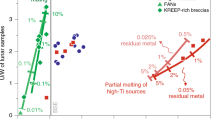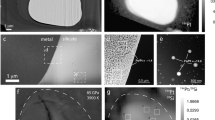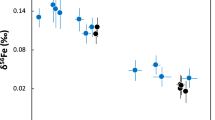Abstract
Yin and Jacobsen1 and Kamber and Kramers2 highlight several issues to do with the tungsten (W) and lead (Pb) isotopic chronometry of terrestrial accretion and core segregation, although none of these affect our model or conclusions3. Yin and Jacobsen1 suggest that it is not clear from our analysis3 that 182Hf−182W provides a reliable system of chronometry for the bulk of core formation, whereas 235/238U−207/206Pb relates to the very last stage of sulphide segregation —which was exactly our point3 and is clarified here.
This is a preview of subscription content, access via your institution
Access options
Subscribe to this journal
Receive 51 print issues and online access
$199.00 per year
only $3.90 per issue
Buy this article
- Purchase on Springer Link
- Instant access to full article PDF
Prices may be subject to local taxes which are calculated during checkout
Similar content being viewed by others
References
Yin, Q.-Z. & Jacobsen, S. B. Nature 444, doi:0.1038/nature05358 (2006).
Kamber, B. S. & Kramers, J. D. Nature 444, doi:10.1038/nature05359 (2006).
Wood, B. J. & Halliday, A. N. Nature 437, 1345–1348 (2005).
Halliday, A. N. Nature 427, 505–509 (2004).
Halliday, A. N. in Meteorites, Comets and Planets Vol. 1 (ed. Davis, A. M.) 509–557 (Elsevier–Pergamon, Oxford, 2003).
Galer, S. J. G. & Goldstein, S. L. in Earth Processes: Reading the Isotope Code (eds Basu, A. & Hart, S.) 75–98 (AGU, Washington DC, 1996).
Allègre, C. J., Manhès, G. & Göpel, C. Geochim. Cosmochim. Acta 59, 1445–1456 (1995).
Lodders, K. Astrophys. J. 591, 1220–1247 (2003).
Kramers, J. D. & Tolstikhin, I. N. Chem. Geol. 139, 75–110 (1997).
Murphy, D. T., Kamber, B. S. & Collerson, K. D. J. Petrol. 44, 39–53 (2003).
Yin, Q.-Z. et al. Nature 418, 949–952 (2002).
Lee, D.-C., Halliday, A. N., Snyder, G. A. & Taylor, L. A. Science 278, 1098–1103 (1997).
Lee, D.-C., Halliday, A. N., Leya, I., Wieler, R. & Wiechert, U. Earth Planet. Sci. Lett. 198, 267–274 (2002).
Kleine, T., Palme, H., Mezger, K. & Halliday, A. N. Science 310, 1671–1674 (2005).
Lee, D.-C. & Halliday, A. N. Nature 378, 771–774 (1995).
Author information
Authors and Affiliations
Corresponding author
Rights and permissions
About this article
Cite this article
Wood, B., Halliday, A. Does U–Pb date Earth's core formation?; How well can Pb isotopes date core formation? (Reply). Nature 444, E2–E3 (2006). https://doi.org/10.1038/nature05360
Published:
Issue Date:
DOI: https://doi.org/10.1038/nature05360
Comments
By submitting a comment you agree to abide by our Terms and Community Guidelines. If you find something abusive or that does not comply with our terms or guidelines please flag it as inappropriate.



